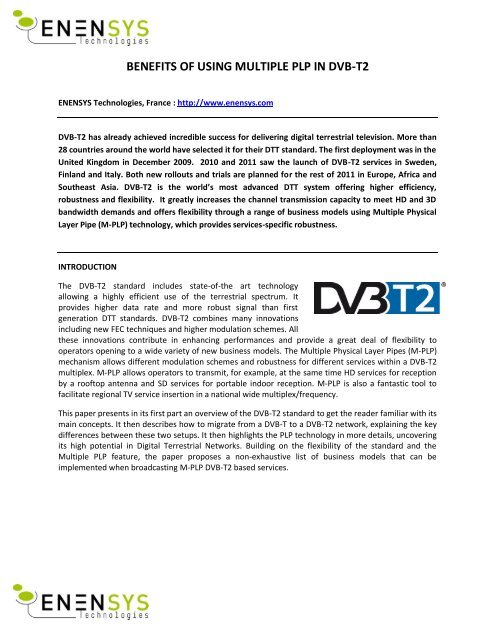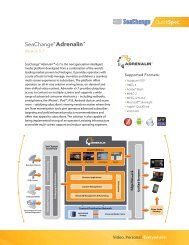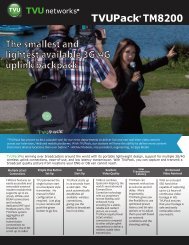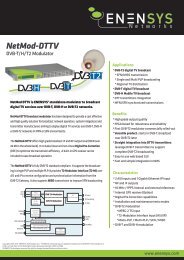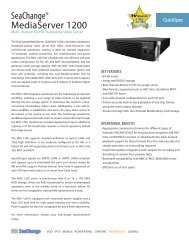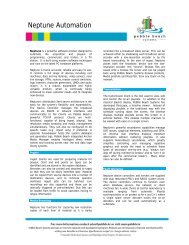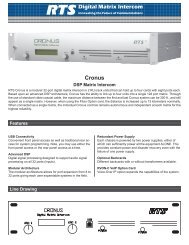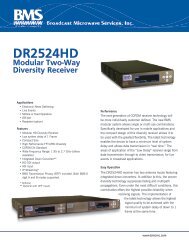Benefits of using multiple PLP in DVB-T2.pdf - Enensys
Benefits of using multiple PLP in DVB-T2.pdf - Enensys
Benefits of using multiple PLP in DVB-T2.pdf - Enensys
Create successful ePaper yourself
Turn your PDF publications into a flip-book with our unique Google optimized e-Paper software.
BENEFITS OF USING MULTIPLE <strong>PLP</strong> IN <strong>DVB</strong>-T2<br />
ENENSYS Technologies, France : http://www.enensys.com<br />
<strong>DVB</strong>-T2 has already achieved <strong>in</strong>credible success for deliver<strong>in</strong>g digital terrestrial television. More than<br />
28 countries around the world have selected it for their DTT standard. The first deployment was <strong>in</strong> the<br />
United K<strong>in</strong>gdom <strong>in</strong> December 2009. 2010 and 2011 saw the launch <strong>of</strong> <strong>DVB</strong>-T2 services <strong>in</strong> Sweden,<br />
F<strong>in</strong>land and Italy. Both new rollouts and trials are planned for the rest <strong>of</strong> 2011 <strong>in</strong> Europe, Africa and<br />
Southeast Asia. <strong>DVB</strong>-T2 is the world’s most advanced DTT system <strong>of</strong>fer<strong>in</strong>g higher efficiency,<br />
robustness and flexibility. It greatly <strong>in</strong>creases the channel transmission capacity to meet HD and 3D<br />
bandwidth demands and <strong>of</strong>fers flexibility through a range <strong>of</strong> bus<strong>in</strong>ess models <strong>us<strong>in</strong>g</strong> Multiple Physical<br />
Layer Pipe (M-<strong>PLP</strong>) technology, which provides services-specific robustness.<br />
INTRODUCTION<br />
The <strong>DVB</strong>-T2 standard <strong>in</strong>cludes state-<strong>of</strong>-the art technology<br />
allow<strong>in</strong>g a highly efficient use <strong>of</strong> the terrestrial spectrum. It<br />
provides higher data rate and more robust signal than first<br />
generation DTT standards. <strong>DVB</strong>-T2 comb<strong>in</strong>es many <strong>in</strong>novations<br />
<strong>in</strong>clud<strong>in</strong>g new FEC techniques and higher modulation schemes. All<br />
these <strong>in</strong>novations contribute <strong>in</strong> enhanc<strong>in</strong>g performances and provide a great deal <strong>of</strong> flexibility to<br />
operators open<strong>in</strong>g to a wide variety <strong>of</strong> new bus<strong>in</strong>ess models. The Multiple Physical Layer Pipes (M-<strong>PLP</strong>)<br />
mechanism allows different modulation schemes and robustness for different services with<strong>in</strong> a <strong>DVB</strong>-T2<br />
<strong>multiple</strong>x. M-<strong>PLP</strong> allows operators to transmit, for example, at the same time HD services for reception<br />
by a ro<strong>of</strong>top antenna and SD services for portable <strong>in</strong>door reception. M-<strong>PLP</strong> is also a fantastic tool to<br />
facilitate regional TV service <strong>in</strong>sertion <strong>in</strong> a national wide <strong>multiple</strong>x/frequency.<br />
This paper presents <strong>in</strong> its first part an overview <strong>of</strong> the <strong>DVB</strong>-T2 standard to get the reader familiar with its<br />
ma<strong>in</strong> concepts. It then describes how to migrate from a <strong>DVB</strong>-T to a <strong>DVB</strong>-T2 network, expla<strong>in</strong><strong>in</strong>g the key<br />
differences between these two setups. It then highlights the <strong>PLP</strong> technology <strong>in</strong> more details, uncover<strong>in</strong>g<br />
its high potential <strong>in</strong> Digital Terrestrial Networks. Build<strong>in</strong>g on the flexibility <strong>of</strong> the standard and the<br />
Multiple <strong>PLP</strong> feature, the paper proposes a non-exhaustive list <strong>of</strong> bus<strong>in</strong>ess models that can be<br />
implemented when broadcast<strong>in</strong>g M-<strong>PLP</strong> <strong>DVB</strong>-T2 based services.
<strong>DVB</strong>-T2 OVERVIEW<br />
The European-based <strong>DVB</strong> consortium elaborated the <strong>DVB</strong>-T2 specification as an extension <strong>of</strong> the exist<strong>in</strong>g<br />
standard <strong>DVB</strong>-T, <strong>in</strong> order to allow a better use <strong>of</strong> the spectral resources by <strong>in</strong>tegrat<strong>in</strong>g the latest signal<br />
process<strong>in</strong>g technologies. <strong>DVB</strong>-T2 <strong>multiple</strong>xes can reach an overall throughput <strong>of</strong> 50Mb/s compared to<br />
the 32 Mb/s <strong>in</strong> <strong>DVB</strong>-T.<br />
Like <strong>DVB</strong>-T, <strong>DVB</strong>-T2 relies on the OFDM (orthogonal frequency division <strong>multiple</strong>x) modulation to<br />
transmit the signal but supports a wider range <strong>of</strong> transmission parameters. It enables higher FFT size<br />
(16K and 32K) that can be extended to deliver more data. It def<strong>in</strong>es new Guard Interval Fractions (GIF)<br />
to maximize the bandwidth utilization and to provide a better robustness aga<strong>in</strong>st impulse noise. New<br />
pilot patterns have been also specified to provide more flexibility <strong>in</strong> order to reduce the pilot overhead.<br />
Whereas <strong>DVB</strong>-T is limited to a constellation <strong>of</strong> 64 QAM, <strong>DVB</strong>-T2 can support <strong>in</strong> addition a constellation<br />
<strong>of</strong> 256 QAM that <strong>in</strong>creases the capacity <strong>of</strong> the spectrum by about 30%.<br />
Table 1: UK network capacity comparison between <strong>DVB</strong>-T and <strong>DVB</strong>-T2<br />
The Forward Error Correction (FEC) scheme used on the physical transmission layer relies on the LDPC<br />
and BCH algorithm to support a higher robustness dur<strong>in</strong>g reception under bad conditions. In addition,<br />
the <strong>DVB</strong>-T2 standard benefits <strong>of</strong> several <strong>in</strong>terleavers at the bit, cell, time and frequency level allow<strong>in</strong>g a<br />
better robustness aga<strong>in</strong>st impulse noise.<br />
<strong>DVB</strong>-T2 standard takes also care <strong>of</strong> transmitter equipment. Particularly <strong>in</strong> 32k, where the high power<br />
peaks are generated and thus m<strong>in</strong>imize the amplifier efficiency (or can even damage it). A special<br />
feature called PAPR (Peak Average Power Ratio) reduction has been <strong>in</strong>cluded <strong>in</strong> the standard<br />
specifications to limit these power peaks without los<strong>in</strong>g <strong>in</strong>formation.
T2 Signal structure<br />
The <strong>DVB</strong>-T2 standard def<strong>in</strong>es a new fram<strong>in</strong>g structure for the <strong>DVB</strong>-T2 signal. The physical frame<br />
structure is composed <strong>of</strong> super frames, T2 frames, FEF and symbols. Super-frames can conta<strong>in</strong> up to 255<br />
T2 Frames (2 are recommended). Future Extension Frames shall carry frames def<strong>in</strong>ed <strong>in</strong> the future <strong>DVB</strong><br />
standard, possibly NGH. The maximum duration length <strong>of</strong> a T2 frame is 250 ms so that all the system is<br />
set up to be as close as possible to this maximum value to have the better performance. A T2 frame is<br />
divided <strong>in</strong>to three parts: one P1 preamble that is a robust symbol to identify a <strong>DVB</strong>-T2 signal, one P2<br />
preamble that carries the signal<strong>in</strong>g describ<strong>in</strong>g the content and the structure <strong>of</strong> the T2 frame and data<br />
symbols that carries the <strong>DVB</strong>-T2 services with<strong>in</strong> OFDM symbols.<br />
The logical fram<strong>in</strong>g structure <strong>in</strong>cludes BB-Frames, Interleav<strong>in</strong>g frames and TI-blocks. With<strong>in</strong> a <strong>DVB</strong>-T2<br />
system, BB-frames are the basic unit <strong>in</strong> the logical fram<strong>in</strong>g structure <strong>of</strong> <strong>DVB</strong>-T2: allocation and<br />
schedul<strong>in</strong>g are performed <strong>in</strong> whole number <strong>of</strong> BB-Frames. One FEC-Frame carries exactly one BB-Frame<br />
add<strong>in</strong>g BCH and LDPC FEC <strong>in</strong>formation.<br />
S<strong>in</strong>gle Frequency Network<br />
<strong>DVB</strong>-T2 allows s<strong>in</strong>gle frequency networks (SFN) operation with<strong>in</strong> a given geographical area, where two<br />
or more transmitters carry<strong>in</strong>g the same data operate on the same frequency. In such cases the signals<br />
from each transmitter <strong>in</strong> the SFN needs to be accurately time-aligned, which is done with<br />
synchronization <strong>in</strong>formation <strong>in</strong> the T2MI stream added by the T2 Gateway. The <strong>DVB</strong>-T2 standard also<br />
<strong>in</strong>cludes Multiple Input S<strong>in</strong>gle Output (MISO) based on Alamouti cod<strong>in</strong>g mode. The key benefit com<strong>in</strong>g<br />
from the MISO SFN is observed by less degradation <strong>in</strong> term <strong>of</strong> m<strong>in</strong>imum receiver <strong>in</strong>put power, while a<br />
degradation <strong>of</strong> several dB is measured <strong>in</strong> SISO-SFN (caused by the fad<strong>in</strong>g effects that are lead<strong>in</strong>g to the<br />
spectral cancellations).<br />
Physical Layer Pipes (<strong>PLP</strong>)<br />
The <strong>PLP</strong> concept is <strong>in</strong>herited from the <strong>DVB</strong>-S2 standard. It allows service-specific robustness. Every <strong>PLP</strong><br />
can have its own modulation, FEC code rate and <strong>in</strong>terleav<strong>in</strong>g. All <strong>PLP</strong>s are broadcast over the same<br />
frequency so that it is considered as a s<strong>in</strong>gle <strong>DVB</strong>-T2 channel.<br />
Figure 1: <strong>PLP</strong> concept
A <strong>DVB</strong>-T2 <strong>multiple</strong>x can carry a s<strong>in</strong>gle <strong>PLP</strong>, def<strong>in</strong>ed as <strong>in</strong>put mode A, or <strong>multiple</strong> <strong>PLP</strong>, def<strong>in</strong>ed as <strong>in</strong>put<br />
mode B <strong>of</strong> the T2 system. A T2 system can broadcast a maximum <strong>of</strong> 255 <strong>PLP</strong> per <strong>multiple</strong>x.<br />
There are 3 types <strong>of</strong> <strong>PLP</strong> : common <strong>PLP</strong> <strong>of</strong> type 0 that carries <strong>in</strong>formation extracted from the other data<br />
<strong>PLP</strong> such as program guide, or other common <strong>in</strong>formation.<br />
<strong>PLP</strong> type 1 conta<strong>in</strong>s 1 slice per T2 frame while type 2 conta<strong>in</strong>s several slices to carry the actual data.<br />
The data <strong>PLP</strong> <strong>of</strong> type 1 can be used for services that require a good power sav<strong>in</strong>g.<br />
Figure 2: <strong>PLP</strong> type 1 with one slice per T2 Frame<br />
The data <strong>PLP</strong> <strong>of</strong> type 2 is carried <strong>in</strong> <strong>multiple</strong> sub-slices per T2 frames <strong>in</strong>creas<strong>in</strong>g time diversity and then<br />
provid<strong>in</strong>g better robustness for mobile services. The number <strong>of</strong> sub-slices should be as large as possible.<br />
Figure 3: <strong>PLP</strong> type 2 with several sub-slices per T2 Frame<br />
In M-<strong>PLP</strong> mode, the demodulator shall receive at the same time the common <strong>PLP</strong> and one data <strong>PLP</strong> to<br />
be able to build the MPEG-2 Transport Stream as it is received at the <strong>in</strong>put <strong>of</strong> the <strong>PLP</strong> builder. The<br />
demodulator can be tuned to the desired <strong>PLP</strong> thanks to the <strong>in</strong>formation extracted from the SI tables or<br />
retrieved from the scann<strong>in</strong>g. As the demodulator is supposed to read only one <strong>PLP</strong> at a given time there<br />
is no limitation <strong>in</strong> the receiver side on the number <strong>of</strong> supported <strong>PLP</strong>.<br />
Some parameters are common to all <strong>PLP</strong>, such as central frequency, SFN/MISO, bandwidth, guard<br />
<strong>in</strong>ternal, FFT size or scattered pilot pattern. And some parameters are <strong>PLP</strong> specific such as constellation,<br />
code rate, FEC, TS bit rate and time <strong>in</strong>terleav<strong>in</strong>g depth.
In a regular <strong>DVB</strong>-T system only one MPTS can be broadcast per <strong>DVB</strong>-T channel. In a <strong>DVB</strong>-T2 system each<br />
<strong>PLP</strong> must conta<strong>in</strong> consistent TS. So a simplified T2 system can be seen as several MPTS shar<strong>in</strong>g the same<br />
channel without the need <strong>of</strong> <strong>multiple</strong>x<strong>in</strong>g these MPTS together at the head-end.<br />
Figure 4: High level M-<strong>PLP</strong> T2 block diagram<br />
MIGRATING TO <strong>DVB</strong>-T2 NETWORK<br />
The <strong>DVB</strong>-T2 commercial requirements enforced the re-use <strong>of</strong> domestic receiv<strong>in</strong>g antenna <strong>in</strong>stallations as<br />
well as exist<strong>in</strong>g transmitter <strong>in</strong>frastructure. The result<strong>in</strong>g standard fulfills this requirement but mandates<br />
the update <strong>of</strong> equipment (modulators, de-modulators) or the <strong>in</strong>sertion <strong>of</strong> new ones (T2 Gateway).<br />
Roll<strong>in</strong>g-out <strong>DVB</strong>-T2 services has also an impact on the test and monitor<strong>in</strong>g cha<strong>in</strong> s<strong>in</strong>ce new modulation<br />
parameters, protocols and services have been def<strong>in</strong>ed <strong>in</strong> the <strong>DVB</strong>-T2 standard.<br />
From <strong>DVB</strong>-T to <strong>DVB</strong>-T2<br />
Migrat<strong>in</strong>g to <strong>DVB</strong>-T2 architecture implies the <strong>in</strong>sertion <strong>of</strong> the T2 Gateway at the head-end, the update <strong>of</strong><br />
<strong>DVB</strong>-T modulators to <strong>DVB</strong>-T2 modulators, as well as the replacement <strong>of</strong> STB or iTV with the new <strong>DVB</strong>-T2<br />
front-ends. The architecture rema<strong>in</strong>s the same for either S<strong>in</strong>gle <strong>PLP</strong> or M-<strong>PLP</strong> modes.<br />
Figure 5: High level network architecture
<strong>DVB</strong>-T2 key network elements<br />
The T2 Gateway aims at encapsulat<strong>in</strong>g the <strong>in</strong>com<strong>in</strong>g MPEG-2 TS <strong>in</strong>to baseband frames, <strong>in</strong>sert<strong>in</strong>g<br />
synchronization <strong>in</strong>formation for SFN broadcast<strong>in</strong>g, controll<strong>in</strong>g modulators configuration, schedul<strong>in</strong>g the<br />
M-<strong>PLP</strong> broadcast<strong>in</strong>g as well as the TFS allocation.<br />
The T2 Modulators receive configuration from the T2 Gateway, perform the channel encod<strong>in</strong>g by add<strong>in</strong>g<br />
the forward error correction <strong>in</strong>formation, build the T2 frames, and modulate the signal prior to transmit<br />
it over the air. A <strong>DVB</strong>-T amplifier could be used to broadcast <strong>DVB</strong>-T2 by upgrad<strong>in</strong>g its <strong>DVB</strong>-T modulator<br />
by a <strong>DVB</strong>-T2 one.<br />
The <strong>DVB</strong>-T2 standard has def<strong>in</strong>ed a new protocol <strong>in</strong>terface the T2-MI (T2-Modulator Interface) to<br />
communicate between the T2 Gateway and the Modulators. The T2-MI packets carry the data<br />
encapsulated <strong>in</strong>to BB Frames, provide for synchronization <strong>in</strong>formation when broadcast<strong>in</strong>g over SFN and<br />
<strong>in</strong>clude all the signal<strong>in</strong>g <strong>in</strong>formation for the transmission. All the <strong>PLP</strong>, TFS, SFN features are scheduled<br />
from the T2 Gateway and described with<strong>in</strong> specific T2-MI packets.
<strong>DVB</strong>-T2 MULTI-<strong>PLP</strong> POSSIBLE BUSINESS MODELS<br />
The <strong>PLP</strong> concept allows a wide range <strong>of</strong> bus<strong>in</strong>ess models. Operators can differentiate easily services on a<br />
<strong>PLP</strong> basis with an <strong>of</strong>fer<strong>in</strong>g that varies <strong>in</strong> accordance with the robustness level.<br />
QoS classes scenario: One possible scenario is the ability to use different modulation schemes to enable<br />
wide range <strong>of</strong> different QoS classes for each <strong>PLP</strong>. This scenario enable, for example, high data rate <strong>PLP</strong><br />
for 3D/HD content reception by a ro<strong>of</strong>top antenna, a second <strong>PLP</strong> dedicated for <strong>in</strong>door SD reception and<br />
a third <strong>PLP</strong> with high robustness for mobile TV or radio reception.<br />
Figure 6: QoS classes scenario<br />
In this scenario it’s possible to achieve, for example, the configuration below.<br />
Common parameters : 8 Mhz channel, FFT size 8K, pilot pattern PP1 and Guard Interval 1/4<br />
<strong>PLP</strong> Content Reception Modulation Code rate Bit rate C/N<br />
1 HD/3D Ro<strong>of</strong>top antenna 256 QAM 3/4 18.6 Mbps 23 dB<br />
2 SD Indoor antenna 16 QAM 3/5 4 Mbps 11 dB<br />
3 Mobile/radio Mobile reception QPSK 1/2 0.5 Mbps 3 dB<br />
This example shows 12 dB difference <strong>in</strong> C/N between the two first <strong>PLP</strong> to enable <strong>in</strong>door coverage and<br />
additional ga<strong>in</strong> <strong>of</strong> 8 dB for the third <strong>PLP</strong> to enable mobile reception. The time <strong>in</strong>terleaver <strong>in</strong>troduced by<br />
sub-slic<strong>in</strong>g usage provides also additional robustness for mobile services reception.
This is just an example and various configurations are possible, but this scenario illustrates the different<br />
robustness and bitrate that can be achieved with M-<strong>PLP</strong> configuration <strong>in</strong> a s<strong>in</strong>gle <strong>DVB</strong>-T2 channel.<br />
T2-Lite: The T2-Lite pr<strong>of</strong>ile is mostly a subset <strong>of</strong> the <strong>DVB</strong>-T2 standard. Two additional code rates were<br />
added to improve <strong>of</strong> mobile performance. T2-Lite is based on M-<strong>PLP</strong> where T2-Lite services can be<br />
transmitted <strong>in</strong> a specific <strong>PLP</strong> besides <strong>PLP</strong> with fixed services. The maximum data rates for a T2-Lite <strong>PLP</strong><br />
shall not exceed 4 Mbps<br />
Figure 7: T2-Lite <strong>PLP</strong> frame structure<br />
Frequency shar<strong>in</strong>g by several content providers: In some countries, content providers have been<br />
allocated only for a part <strong>of</strong> a given frequency resource. In a <strong>DVB</strong>-T network the content providers have<br />
to re-<strong>multiple</strong>x the content all together <strong>in</strong> order to create a s<strong>in</strong>gle MPTS. In this case content providers<br />
don’t have the full control <strong>of</strong> the transmitted MPTS.<br />
Us<strong>in</strong>g <strong>PLP</strong> capability, the allocation <strong>of</strong> the percentage <strong>of</strong> the bandwidth to each content provider can be<br />
managed at the <strong>PLP</strong> level to guarantee bandwidth allocation. This technique allows to make each<br />
operator <strong>in</strong>dependent from each other, by hav<strong>in</strong>g them operat<strong>in</strong>g their own mux and choos<strong>in</strong>g their<br />
own modulation parameters.<br />
Figure 8: Frequency shar<strong>in</strong>g scenario
REGIONAL TV SERVICES INSERTION<br />
Regionalization aims at <strong>of</strong>fer<strong>in</strong>g, <strong>in</strong> addition to national or common TV services, regional or local-specific<br />
content <strong>in</strong>to a region that could be a city, a county or a country. Today out <strong>of</strong> the 1500 TV channels that<br />
are broadcast over a digital terrestrial network, 50% are local channels. Offer<strong>in</strong>g regional programm<strong>in</strong>g<br />
<strong>in</strong> DTT services is now considered mandatory.<br />
Therefore, each region has to broadcast its own <strong>DVB</strong>-T2 <strong>multiple</strong>x composed <strong>of</strong> national and<br />
regional/local content. Regionalization can be operated through different k<strong>in</strong>ds <strong>of</strong> architectures<br />
(national, regional, local) that vary depend<strong>in</strong>g on where the regional or local content is <strong>in</strong>serted.<br />
Another key po<strong>in</strong>t to take <strong>in</strong>to consideration is the necessity to guarantee the S<strong>in</strong>gle Frequency Network<br />
synchronization.<br />
Centralized / National architecture<br />
In a national architecture model, the national TV content is aggregated with regional TV content. Each<br />
region provides the content to the central head-end. Each regional <strong>DVB</strong>-T2 <strong>multiple</strong>x is created from<br />
national content <strong>multiple</strong>x and the regional TV services or regional <strong>multiple</strong>x as described below:<br />
Figure 9: Centralized / National architecture scenario<br />
In that case, for example, the T2 gateway creates the different regional <strong>DVB</strong>-T2 <strong>multiple</strong>x <strong>us<strong>in</strong>g</strong> M-<strong>PLP</strong><br />
technology. Each T2 gateway has one <strong>PLP</strong> dedicated to national TV content and one or several other<br />
data <strong>PLP</strong>s dedicated to regional content. National TV content is retrieved from the national <strong>multiple</strong>xer.<br />
Regional TV content is directly retrieved from the regional encoders or regional <strong>multiple</strong>xers. Then, each<br />
regional <strong>DVB</strong>-T2 <strong>multiple</strong>x is carried towards the different regions from the centralized head-end.<br />
Although this architecture is quite straightforward, it is disadvantaged by hav<strong>in</strong>g to duplicate the<br />
national content on the distribution network as many times as there are regions to address.
Regional architecture<br />
In the regional architecture model, regionalization is performed with<strong>in</strong> regional head-ends. Each<br />
regional head-end receives the national content from the central head-end, <strong>in</strong>serts locally the regional<br />
or local TV content, and then broadcasts the new <strong>DVB</strong>-T2 regional <strong>multiple</strong>x to all transmitters <strong>of</strong> the<br />
correspond<strong>in</strong>g region. In this architecture, the regional T2 gateway outputs a T2-MI stream conta<strong>in</strong><strong>in</strong>g<br />
the national TV <strong>multiple</strong>x <strong>in</strong> one <strong>PLP</strong> and regional TV content <strong>in</strong> other <strong>PLP</strong>s.<br />
Figure 10: Regional architecture scenario<br />
The ma<strong>in</strong> constra<strong>in</strong>ts <strong>of</strong> this architecture are the use <strong>of</strong> 2 distributions channels (from central Head End<br />
to Regional Head End, and from Regional Head End to transmitter sites) and the duplication <strong>of</strong> the<br />
national content <strong>in</strong> the secondary distribution l<strong>in</strong>k for each region.
Local architecture<br />
In the local architecture model, the national T2 gateway generates national content <strong>in</strong> a specific <strong>PLP</strong> and<br />
generates other <strong>PLP</strong>s for content that will be replaced with regional content. The regional content is<br />
generated centrally, regionally or locally through a dedicated regional T2 gateway. In each transmitter<br />
site, a determ<strong>in</strong>istic local T2 <strong>in</strong>serter gets from the distribution network the national T2-MI feed from<br />
the national T2 gateway and the regional T2-MI feed from the regional T2 gateway. The BaseBand<br />
frames (BB frames) data field <strong>of</strong> every T2-MI packet with a match<strong>in</strong>g plp_id field (e.g. plp-id <strong>of</strong> the<br />
regional <strong>PLP</strong>), is then replaced from the national T2-MI feed with the regional T2-MI feed. Employ<strong>in</strong>g<br />
this determ<strong>in</strong>istic method <strong>of</strong> <strong>PLP</strong> substitution ensures SFN preservation.<br />
Figure 11 : Local architecture scenario<br />
This architecture <strong>of</strong>fers a great deal <strong>of</strong> advantages:<br />
• Bandwidth sav<strong>in</strong>g: reduce the OPEX <strong>of</strong> the content delivery to the transmitter sites without<br />
duplicat<strong>in</strong>g the national content delivery<br />
• SFN capable<br />
• Standard-based solution: use <strong>of</strong> M-<strong>PLP</strong> technology<br />
• Statistical <strong>multiple</strong>x<strong>in</strong>g capable between regional or local TV services<br />
• Local TV <strong>in</strong>sertion capable<br />
• Support centralized architecture if the regional contents are available <strong>in</strong> a central po<strong>in</strong>t<br />
• Support distributed architecture if some regional Head-end has to be located <strong>in</strong> other places.
• Support heterogeneous distribution networks if microwave or IP distribution network is<br />
available <strong>in</strong> some regions<br />
• Scalable architecture to enable seamless network extension
CONCLUSIONS<br />
The second generation terrestrial network <strong>DVB</strong>-T2 extends <strong>DVB</strong>-T and provides more robustness,<br />
flexibility and efficiency <strong>in</strong> terms <strong>of</strong> bandwidth, network coverage and transmission power.<br />
Several broadcasters are already <strong>us<strong>in</strong>g</strong> the power <strong>of</strong> <strong>DVB</strong>-T2 to launch new attractive services and today<br />
already 28 countries have adopted or deployed a <strong>DVB</strong>-T2-based network. Some trials <strong>in</strong> Germany and<br />
S<strong>in</strong>gapore already demonstrate the benefits <strong>of</strong> M-<strong>PLP</strong> usage. Moreover the roll-out <strong>of</strong> the first<br />
commercial M-<strong>PLP</strong> network is already under deployment <strong>in</strong> Africa.<br />
M-<strong>PLP</strong> provides maximum flexibility, without any drawback or overhead. Network equipment is<br />
available and deployed. There is also no additional complexity <strong>in</strong> the network compared to s<strong>in</strong>gle <strong>PLP</strong><br />
deployment. <strong>DVB</strong>-T2 chipsets are already M-<strong>PLP</strong> compliant and end-user receivers are now available<br />
without extra-cost for the support <strong>of</strong> M-<strong>PLP</strong>. Thanks to the ongo<strong>in</strong>g deployments one can assume that<br />
the new receivers on the market will all support M-<strong>PLP</strong> as a standard feature.<br />
The M-<strong>PLP</strong> feature <strong>of</strong> <strong>DVB</strong>-T2 opens to a wide range <strong>of</strong> new bus<strong>in</strong>ess models (such as different QoS<br />
classes, regionalization, bandwidth shar<strong>in</strong>g) that broadcasters can take advantage to monetize the<br />
spectrum.<br />
Likewise any DTTV deployment, regional services <strong>in</strong>sertion is a key po<strong>in</strong>t for DTTV service success; with<br />
the Multiple <strong>PLP</strong> technology, <strong>DVB</strong>-T2 <strong>of</strong>fers different ways to carry out this local channel <strong>in</strong>sertion <strong>in</strong> a<br />
nation-wide rollout, <strong>in</strong> a much more efficient and flexible way than any other Digital TV standard. The<br />
National, Regional and Local architectures presented <strong>in</strong> this paper have their own advantages and<br />
disadvantages, which depend on several factors, such as country geography, distribution network<br />
topology and cost, service type and so on. If broadcasters have to assess the pros and cons <strong>of</strong> each one<br />
depend<strong>in</strong>g on their own constra<strong>in</strong>ts before choos<strong>in</strong>g the right option, it is a matter <strong>of</strong> fact that <strong>DVB</strong>-T2<br />
provides them with much more cost effective options than any other Digital TV standard.<br />
References<br />
1. ETSI EN 302 755 V1.3.1 "Frame structure channel cod<strong>in</strong>g and modulation for a second generation<br />
digital terrestrial television broadcast<strong>in</strong>g system (<strong>DVB</strong>-T2)"<br />
2. <strong>DVB</strong> BlueBook A136 "Modulator Interface (T2-MI) for a second generation digital terrestrial television<br />
broadcast<strong>in</strong>g system (<strong>DVB</strong>-T2)"


